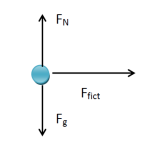Relativistic mechanics, science concerned with the motion of bodies whose relative velocities approach the speed of light c, or whose kinetic energies are comparable with the product of their masses m and the square of the velocity of light, or mc².
Such bodies are said to be relativistic, and when their motion is studied, it is necessary to take into account Einstein’s special theory of relativity. As long as gravitational effects can be ignored, which is true so long as gravitational potential energy differences are small compared with mc², the effects of Einstein’s general theory of relativity may be safely ignored.
Inertial and Non Inertial Frames of Reference:
Inertia – resistance of an object to change its state of motion.
Inertial Frame of Reference : Non accelerating
Newton’s 1st law and other laws of physics are valid
For example:
Inside a bus moving at constant velocity with a ball inside
Non-inertial Frame of Reference : Accelerating
Newton’s 1st law does not hold
For example:
If you are in the bus when it starts to slow down (Accelerating backward) the ball seems to be accelerating forward inside the bus. No external force has acted on the ball so how can it be accelerating?
There appears to be an external force because we see it from an accelerated frame of reference inside the bus (non inertial frame).
From an inertial frame (such as the ground)
The bus will slow down
The ball inside the bus will continue to move at a constant velocity (as explained by Newton’s 1st Law)
To explain the motion observed in non-inertial frames we can invent fictitious forces.
For the ball inside the bus as it slows down:
Or we examine the motion from an inertial frame.



